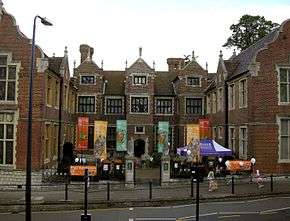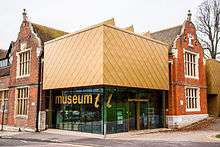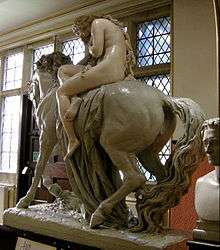Maidstone Museum & Art Gallery
 Maidstone Museum original entrance (since replaced by a newly built entrance lobby) | |
| Established | 1858 |
|---|---|
| Location | St Faiths Street, Maidstone, Kent, England ME14 1LH |
| Type | Regional museum, regimental museum, art gallery, heritage centre, historic house museum |
| Public transit access |
Maidstone public transport Maidstone East railway station; Arriva Southern Counties for buses. |
| Website | Museum.maidstone.gov.uk |
Maidstone Museum & Bentlif Art Gallery a local authority-run museum located in Maidstone, Kent, England, featuring internationally important collections including fine art, natural history, and human history.
Overview
In 1855 Thomas Charles, a local doctor and antiquarian, left his collections of art and antiquities to Maidstone Borough Council,[1] requesting that his executors, “make such arrangements as they should think fit for the permanent preservation thereof in the town of Maidstone, and the same to be called the Charles Museum.” The Council subsequently acquired Charles’ house, Chillington Manor,[1][2] from his executors and, in 1858, opened it as the Charles Museum, later renamed Maidstone Museum. The Museum was one of the first to be opened as a result of the Museums Act (1845) and was a founder member of the Museums Association (1909). Maidstone Museum celebrated its 150th anniversary in 2008.
This museum contains over 600,000 artefacts and specimens. Its collections, housed in the centre of Kent’s county town, are among the most comprehensive in the South East. The Museum is one of three operated by Maidstone Borough Council - alongside the Queen's Own Royal West Kent Regimental Museum and the Tyrwhitt-Drake Museum of Carriages - and is open six days a week. Admission is free.
Building


The Museum's central core consists of an Elizabethan manor house, formerly known as Chillington Manor,[2] completed in 1577 with earlier Tudor buildings to its rear. In the early 18th century a substantial wing was added to the west of the Tudor house. Upon the death of Thomas Charles an in accordance with his estate, Maidstone Borough Council purchased the building in 1856 for the sum of £1,200, investing a further £300 for repairs.[1] On January 20, 1858, the Museum opened as one of the UK's first local authority-run museums, appointing Edward Petty - a friend of the late Thomas Charles - as the museum's first curator in September.
After its opening as a museum, the building was further extended to house the growing collections. A new east wing was added in 1869, matched by new wing to the west in 1873 made possible by donations from Julius Brenchley.[1]
The eastern elevation was extended in 1889 to accommodate the Bentlif Art Gallery funded by Samuel Bentlif to house the art collection amassed by his brother, George. On the western side, the Victoria Gallery, housing the town’s library, was built between 1897 and 1899 to commemorate Queen Victoria's Diamond Jubilee. It operated as a free public lending library until 1936. In 1924, the Bentlif Wing was extended and, in 1973, a new collection store was added to the east wing.
Maidstone Museum & Bentlif Art Gallery is Grade II* listed.[1]
The range of historic buildings (and 11 different floor levels) makes access to some parts of the Museum difficult. Significant improvements have been made recently to ensure that the Museum meets the requirements of the Disability Discrimination Act, but some work must still be done to provide full access.
Public toilets, disabled bathrooms, and baby-changing facilities are all available, and access to the first floor temporary exhibition area, art gallery, Japanese collection, and meeting room is provided by a lift.
Regimental Museum
The Queen's Own Royal West Kent Regiment Museum, an independent charitable trust, has been housed in the Museum since 1964 and forms one of Maidstone Museum’s fifteen public galleries. Its collection of regimental memorabilia features over 3,000 medals, including four Victoria Crosses.[3]
Collections

The Museum is recognised as having the largest mixed collections in the county and one of the most important in the south-east of England, outside London. Whilst its origins are typical of a regional museum created through Victorian munificence, the work of collectors, staff and benefactors over almost 150 years has created a comprehensive collection of worldwide significance. The collections consist of over 600,000 artefacts and specimens.
Three collections are of national importance:
- Anglo-Saxon - the best collection of artefacts from the richest Anglo-Saxon region of Britain.[4]
- Japanese – one of the largest and most important collections outside London.
- The Brenchley Collection – a large and diverse collection of worldwide ethnography, natural history and fine and decorative art collected by a mid-Victorian explorer: Julius Brenchley.[1]
On 9 October 2008 the museum's acquisition and disposal policy[5] was issued. Much of the following information on the collections is based on this document.
Human History
The Human History collections contain approximately 125,000 artefacts. The British archaeology collection covers Kent and beyond; the internationally recognized Anglo-Saxon collection comprises approximately 4,000 Kentish artefacts.[6] Foreign archaeology includes pieces such as the Gandhara heads and over 400 Egyptian artefacts.[7] A new acquisition in 2009 was the kernos from Melos in Greece; it is early Cycladic III period and 4000 years old. There are only eight of these in the world, and this one was possibly used to hold various offerings, such as honey and oats.[8]
The local history collections are varied and relate to all areas of local life. There are collections of arms and armour, clocks and watches and a collection of over 18,000 coins and medals. The collection of photographs and maps is of local importance and is complemented by over 10,000 items of printed ephemera relating to the history of Kent.[9]
There are internationally important collections of artefacts of Pacific, Oceanic and African ethnography as well as diverse material from Asia and North and South America.[10] Napoleon's chair has been held in the museum since 1866. It was one of a pair in the house of Reverend Richard Boys on St Helena, and after Napoleon was exiled there in 1815 he habitually sat in this chair, conversed with Boys and damaged the chair with his penknife while talking.[11]
The arts
The Fine and Applied Art collections comprise approximately 25,000 items. They include 17th to 19th century furniture, musical instruments, toys and games, ceramics, glass, costumes and needlework, paintings, prints and drawings and sculpture.[12] One exhibit beloved of the local people is the Lady Godiva statue by John Thomas (1813–1862). There is a YouTube video of the statue here.
The ceramics holdings form the most significant collection in the region with around 700 English pieces as well as around 250 European pieces. The collection of Chinese ceramics, mostly of 17th to 19th century date, is comprehensive.
Approximately 8,000 specimens of costume date from the 17th to 21st century. Complementing needlework collections comprise around 700 specimens, including English embroidery and samplers, European embroideries and Eastern textiles.[13]
The Japanese collections of fine and decorative art material are important and amongst the most studied in the country. They include ceramics, sword fittings, netsuke, lacquer and books as well a series of over 750 Edo-period (1600–1868) woodblock prints.[14]
580 oil paintings include minor continental Old Masters and 19th to 20th century British works. Watercolours include over 200 works by Albert Goodwin, the largest public collection of his work and local artist James Jefferys.[15] There are over 1,000 Kentish topographical drawings, 40 Old Master drawings and over 3,500 prints. The small sculpture collection includes work by Jacob Epstein and Henry Moore.
The museum also holds a few manuscripts including volume 2 of the Lambeth Bible.
Natural history
A collection of around 450,000 specimens in the natural history section includes specimens of national and international significance.[16]
The collections of palaeontology and vascular plants are of national importance, with type, cited and figured specimens; the plants including voucher specimens for Kent and the nationally important Hawkweed (West) Collection. The main strengths of the palaeontology are the marine Cretaceous and Tertiary of Kent, especially Chalk, Lower Greensand and Lenham Beds; but also Gault and London Clay. There is an extensive collection of Pleistocene vertebrate material and fossils from the Kent Coalfield. Rocks (46,000) and minerals (7,000) are represented on a worldwide scale. The museum contains one of the most comprehensive mineral collections in the country outside the national museums.[17]
The bird collections include 1,800 mounted British specimens, 400 foreign birds and over 1,100 cabinet skins. There are also 300 birds’ nests and a collection of bird’s eggs covering most species on the British list.
The Herbarium contains approximately 30,000 specimens representative of the flora of the British Isles. There is also a British collection of some 6,000 specimens of critical genera including Rubus, Taraxacum and Hieracium. The Herbarium collection is the basis of Philp’s Atlas of the Kent Flora.
There is an entomology collection of around 250,000 specimens forming a comprehensive collection of British insects; and an important collection of several thousand shells, mainly of tropical marine origin, but including temperate marine and freshwater, and tropical terrestrial species.
Site development
In September 2007 the Museum was awarded a grant of £2 million from the Heritage Lottery Fund to extend the art gallery wing. Following an architectural design competition managed by RIBA Competitions Hugh Broughton Architects design was chosen. The new wing opened in the summer of 2010 and will include new galleries, better visitors' facilities, improved storage for the collections and the Maidstone Visitor Information Centre. The Maidstone Museum website showreel suggests that the Lady Godiva statue by John Thomas (1813–1862),[18] beloved by generations of local people, may be at last displayed to advantage, in the new Learning department.

External links
- Maidstone Museum & Bentlif Art Gallery website
- Kent TV: video of Maidstone Museum, 7 minutes, February 2009.
- Queen's Own Royal West Kent Regiment Museum website.
- Maidstone's Museum's Lady Godiva statue on Youtube
- KentTVdotcom's Japanese Exhibition at Maidstone Museum video on Youtube
- http://www.facebook.com/pages/Maidstone-Museum-and-the-East-Wing-Extension/136868719676867 Maidstone Museums Official Facebook
References
- 1 2 3 4 5 6 UK, The Hideout. "Collections". www.museum.maidstone.gov.uk. Retrieved 2016-07-12.
- 1 2 For a history of the old manor see: Ditchfield, P. H. & Clinch, G. Memorials of old Kent (Bemrose & Sons, 1907), pp 253-263.
- ↑ Queen's Own Royal West Kent Regiment Museum website.
- ↑ Arthur Percival: Essay on Anglo-Saxon Kent, Faversham, 7 may 2005.
- ↑ Maidstone Museum's acquisition and disposal policy, 2008, PDF file, and same document, HTML version.
- ↑ Maidstone Museum webpage: Archaeology page.
- ↑ Maidstone Museum website: Ancient Egyptians page.
- ↑ Information from exhibit label
- ↑ Maidstone Museum webpage: Local history page.
- ↑ Maidstone Museum webpage: Ethnography page.
- ↑ "Napoleon's chair found in storage". bbc.co.uk. BBC News. 6 July 2009. Retrieved 4 January 2011.
- ↑ Maidstone Museum webpage: Fine and decorative art page.
- ↑ Maidstone Museum webpage: Costume page.
- ↑ Maidstone Museum webpage: Japanese decorative arts and prints page.
- ↑ Pressly, William L (2007). The Artist as Original Genius. p. 112. ISBN 0874139856.
- ↑ Maidstone Museum webpage: Biology page.
- ↑ Maidstone Museum webpage: Geology page.
- ↑ Tiscali: biography of John Thomas (1813-1862)
Coordinates: 51°16′33″N 0°31′14″E / 51.27583°N 0.52056°E




